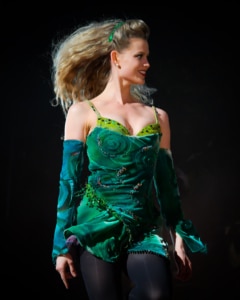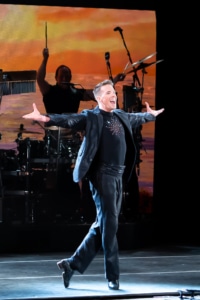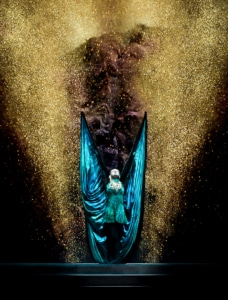DCPA NEWS CENTER
Enjoy the best stories and perspectives from the theatre world today.
Enjoy the best stories and perspectives from the theatre world today.
From the archives: this post was originally published on March 7, 2016
It began as a one-time, seven-minute performance: the intermission entertainment at the music sensation Eurovision, a yearly contest that has launched the likes of Celine Dion and ABBA. The segment opened with the haunting sounds of the Celtic choir Anúna. Then a lone dancer came center stage in a simple black dress. Arms flush at her sides, she cavorted across the boards in an intricate pattern of steps and kicks, accompanied by a fast fiddle.

Riverdance
Next came a leaping Michael Flatley, his shoes keeping time with a corps of Irish drums. And out of the shadows emerged two dozen more Irish dancers, storming the stage in a lightning-quick precision of steps, heels tapping in percussive rhythm and giving a performance of Irish dance unlike anything anyone had ever seen.
Julian Erskine, then-Senior Executive Producer of Riverdance who has since retired, remembers that night. “It’s hard to describe just how enormous [the audience reaction] was. Not just in the Eurovision venue, where the entire audience let out a spontaneous roar and jumped to (its) feet, but also across all the Irish radio and TV stations and newspapers where it was the No. 1 topic of discussion.”
Such a buzz was created that by the time the routine was repeated live on Irish national television the following Saturday, nearly the entire country was watching to see what the fuss was about.
Erskine and the rest of the creative team didn’t quite know what they had on their hands. With the instant popularity of the act, they planned to follow up the Eurovision performance with a full-length dance show to play Dublin. “The original hope,” he said, “was for a one-month run.”
That was 1994. Nearly 30 years later the worldwide phenomenon of Riverdance continues to play to enthusiastic audiences across the globe. To Americans today, the immense and immediate popularity of Riverdance in Ireland may seem odd. Why the fuss? Isn’t Irish dance ingrained in the culture? Not like this, said Erskine.

Riverdance
“It was a unique event, especially for Irish audiences. We were not used to seeing Irish dancing as a form of entertainment, and never on such a big scale. Prior to Riverdance, Irish dancing was a low-key cultural pastime, reserved for competitive amateurs and now and then for small-scale tourist attractions…. This show was the first of a new kind of entertainment.”
Immediately upon opening the show in Dublin in February 1995, the creative team was invited to bring it to London. Soon, worldwide invitations began pouring in and, Erskine said, “it was clear that the show had a much wider appeal and was not limited to playing to Irish audiences.”
Celtic music and culture were already gaining fresh popularity in the US, so taking the show across the pond seemed like a natural step. Erskine: “Our first taste of the American reaction was in March 1996 when we came to Radio City Music Hall for St. Patrick’s week. It was fantastic. We were sold out before we arrived and the whole week was one long celebration.”
So just what is so fascinating about Riverdance? To start, there’s the music of composer Bill Whelan, which includes Irish Uilleann pipes and the Bodhran, a handheld drum covered with goat’s skin and played with a wooden stick. When joined with the fiddle, these instruments form the traditional Irish “seisiun” trio, but to quote Erskine, “Perhaps the least known instruments in the show are the dancers’ shoes. With their hard heels, soles and tips, the dancers are not only able to beat out a rhythm, but they can also make music by using their shoes to create bass and treble notes.” The steps, multiplied by 20 dancers all moving in time together, create music of their own.

Riverdance
Those dancers are the heart of the show — skilled athletes whose precise execution may be rivaled only by the Rockettes. When asked if that point-perfect unison is achieved by endless hours of rehearsal or great choreographic direction, Erskine assessed it as a bit of both.
“Mostly it’s down to the competitive background of Irish dance. All of our performers are championship-winning dancers and as such, perform with extreme precision and exceptional timing, usually under intense pressure.” As most of the dancers have been competing since they were toddlers, this precision and style are deeply rooted. “What seems extraordinary to the audience seems ordinary to the dancers,” he said.
Riverdance now returns to Denver after a seven-year absence, which was postponed due to COVID. During its previous engagement, Erskine was uncertain about what lay ahead for the show but given the enthusiastic embrace Americans have for it he then said, “I would never rule out Riverdance, in some form or other, [continuing to return] to the U.S. in the future. We’re just happy that that future ended up including a stop in Denver during its 25th anniversary world tour.”
DETAILS
Riverdance
May 31-June 4, 2023 • Buell Theatre
Tickets

Leave a Reply
Want to join the discussion?Feel free to contribute!